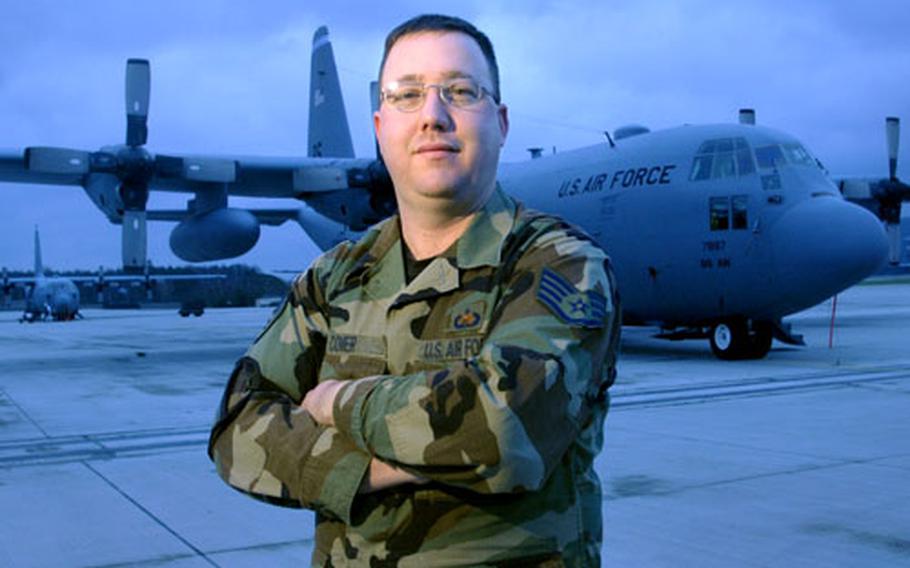
Staff Sgt. Benjamin Comer, a dedicated crew chief assigned to the 86th Aircraft Maintenance Squadron, poses Wednesday in front of his aircraft the day before it retires from active duty at Ramstein Air Base, Germany. The C130E, nicknamed “Ace of Spades,” is being flown to the Aerospace Maintenance and Regeneration Center, known as the “bone yard,” in Arizona after 42 years of service. Tail No. 7887 started its career with five years of service in Vietnam. (Ben Bloker / Stars and Stripes)
RAMSTEIN AIR BASE, Germany — The 86th Airlift Wing will say farewell to one of its “working-class grunts.”
The wing will retire one of its C-130 Hercules because this particular “E” model is no longer considered useful.
Staff Sgt. Benjamin Comer, who has been the plane’s crew chief for the last six months, plans to kiss the plane goodbye before it leaves Ramstein Air Base for the United States on Thursday morning.
It’s a tradition of his to always give the planes he works on a quick peck on the nose before they take off. The Air Force crew chief with the 86th Aircraft Maintenance Squadron is responsible for the upkeep of the planes his unit is assigned.
“I’ve never had a problem getting her to fly,” he said. “She’s been a spectacular plane. It’s sad we have to retire (her). The wings are getting old. It’s time for her to go to a new home for a while.”
Tail No. 7887 is the cargo plane’s official name, but it also goes by the nickname “Ace of Spades.”
The plane, which was delivered to the Air Force on June 5, 1964, is older than many of the squadron’s pilots and mechanics.
The plane will fly to the Aerospace Maintenance and Recovery Center, commonly known as the “boneyard,” at Davis-Monthan Air Force Base in Tucson, Ariz.
It will be stripped of any parts needed to keep the current models flying.
The plane was first assigned to the 464th Troop Carrier Wing at Pope Air Force Base in North Carolina in 1964. Then, it spent five years in Vietnam in the late 1960s before getting an overhaul.
The Air Force transferred the plane to Rhein-Main Air Base, Germany, in 1992 before coming to the 86th at Ramstein in 1995.
This is the first of three C-130Es the wing will retire this year.
The latest model to be added to the Air Force’s fleet, the C-130J, will replace the planes. The newest planes are built to travel farther, faster, quieter, climb higher and require less maintenance than the older versions.
But the new planes won’t arrive at the wing for another couple of years.
Master Sgt. Roger Richardson said retiring an aircraft can be a significant event for maintainers.
“You pour your heart and soul into it,” Richardson said. “And you believe in the mission that it flies and everything that it does … and then a day like this comes along and the aircraft is going to be retired and it just has some sentimental value.”
The flip side, he added, is that the older planes are difficult to maintain and often require extra work to keep flying. Tail No. 7887 was a “restricted” plane and was limited on the missions it could fly because of its age and condition.
Comer, who maintained the plane with Airman 1st Class Jason Keithly, said it will still be hard to see the plane leave.
“It’s been a great plane,” he said.